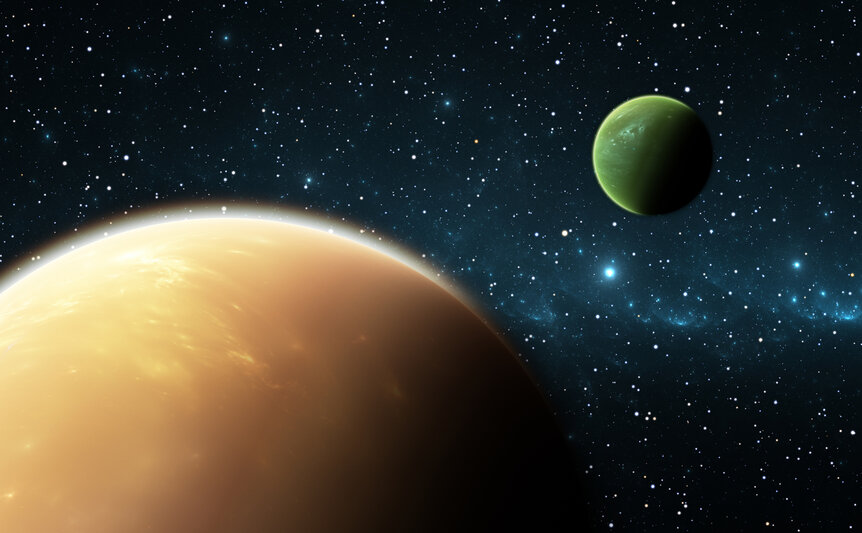Create a free profile to get unlimited access to exclusive videos, sweepstakes, and more!
Looking for other Earths: Are we being too picky?

As I write this, astronomers have confirmed the existence of over 3,500 planets orbiting other stars: Exoplanets.
That's amazing. The first wasn't found until 1992! And now we know of so many that we can categorize them by size, mass, host star type, and more. And that allows for some interesting things to be deduced from the data…
One of the biggest questions we still have sounds simple enough: How many of these planets are like Earth? That is, habitable?
So far, we haven't found any just like Earth, though a couple come close. But we've found quite a few that are the more or less the same size as Earth, so that's a start.
We've also found lots that receive the same amount of light from the star as Earth does from the Sun. That's important, because that means they could be the same temperature as Earth. There's a region around any star where temperatures could allow for liquid water on the surface of a planet, and we call that the habitable zone (or HZ). But it also depends on the planet’s composition, reflectivity (how bright/dark it is), and very much on the atmospheric composition. For example, if we had no carbon dioxide in our atmosphere, Earth would be frozen from poles to Equator. If we had too much, well, take a look at Venus.
However, the problem here too is that many of the planets we find in their stars' HZs are actually gas giants like Jupiter. Those can't support life like us. They don't even have a surface!
Well, hang on a sec. Maybe we're being too picky. After all, those planets might have moons…
Now I know, that sounds weird. But we also know that quite a few moons of gas giants in our own solar system have huge bodies of liquid water under their surfaces despite the massively subzero temperatures on their surfaces. If Jupiter orbited the Sun where Earth does, instead of farther out, those moons might be habitable.
So hey, why not look at all the exoplanets we know about so far and see how many are gas giants in their stars' HZs, and then see if this makes sense?
So some astronomers did just that. They started looked at the stars observed by the Kepler planet-finding observatory, and pulled out the ones that are somewhat like the Sun (ones with temperatures from 2,400 to 6,000 Kelvin, where the Sun's is about 5,800 — these would be class G, K, and M stars). That left them with about 100,000 stars.
In that sample of stars, Kepler found 2,586 planets. The team then broke those up by planet size, assuming that anything with a diameter more than three times Earth's would be a gas giant (a good assumption; once a planet gets that big when it forms its gravity becomes so strong that it should get a thick atmosphere and be more like a gas giant such as Neptune than a smaller, rocky, terrestrial planet like Earth). They also looked for ones with orbits that were 5 to 470 days.
Then they looked to see how many gas giants were in their stars' HZs compared to terrestrial planets. What they found was that terrestrial planets were more common in the HZ than gas giants. So does that mean there aren't many potential habitable moons out there?
Not so fast! Jupiter has four big moons, and lots of smaller icy ones. Saturn too. So we don't have to assume just one moon per planet. If each gas giant in the survey has two big moons, then the numbers of HZ terrestrial planets and HZ moons of gas giants are about the same.
So the numbers are favorable for habitable potential exomoons, which is pretty interesting. But can we detect them?
Maybe! One so-called exomoon may have already have been found (we're still awaiting confirmation). It helps a lot if the moon is widely separated from its host planet… but not too far, or else the planet won't be able to hold onto it. The astronomers ran the numbers, and found that for stars out to about 30 light years away (and there are many), moons of exoplanets might actually be observable in telescopes! It requires a handful of special conditions, though (looking at wavelengths (colors) of light where the moons might actually be brighter than their planets, for example, as well as favorable geometry and so on). My suspicion is that it's unlikely we’ll see one this way soon, but it's possible.
More likely we can detect them via the transit method, where the planet and moon cross the face of their star and block some of its light. This is how most planets are found in the first place, and how the one possibly seen exomoon was detected as well. This is still a tough observation though.
But we're getting better at this sort of thing all the time. I don't think we’ll have to wait too long before we see our first alien moon. After that — if they follow the same pattern as exoplanet findings did back in the '90s and 2000s — we’ll find a few more… and then a lot more.
Will any be habitable? Well, that's still anyone’s guess. But we do know that the galaxy is filled with planets, so the statistics are on our side. If I had to bet on this, I know where I'd put my money.



























